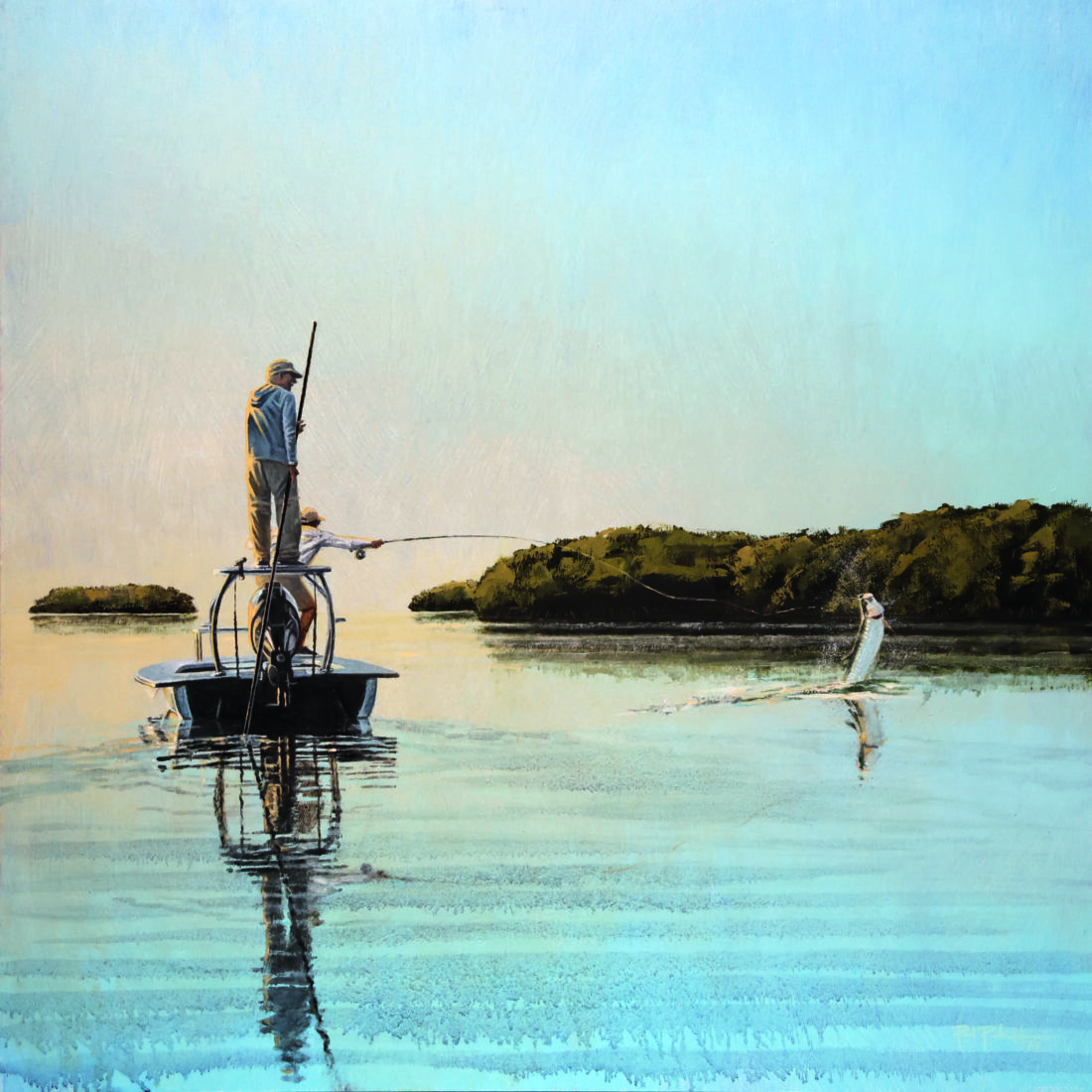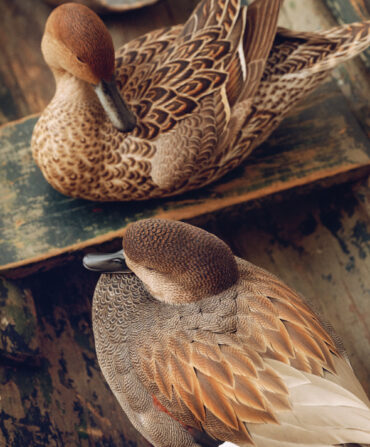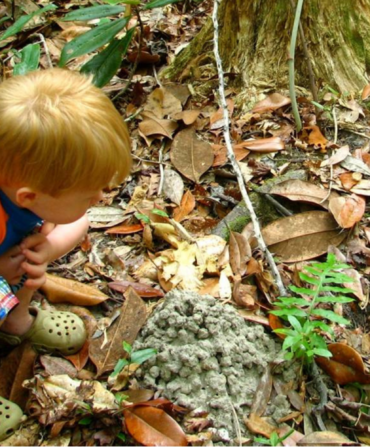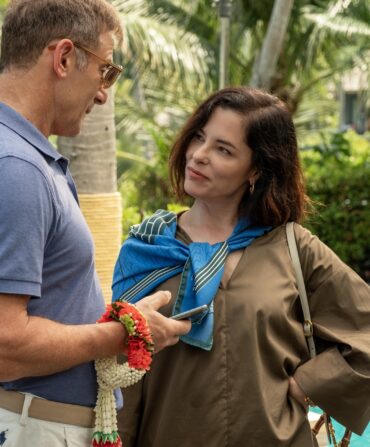We come to a stop at the mouth of a river. Steve Huff, éminence grise of Florida flats guides, cuts the engine. The wash shooshes against the stern. See that creek? He nods toward an opening not much wider than his skiff. We’re going in there.
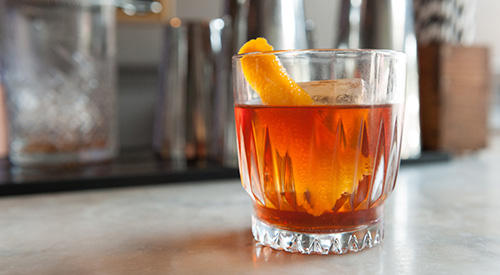
He tilts the motor, grabs the push pole, and ascends his platform. We enter the creek slowly, silently. It is yet another alternate dimension within the mesmeric labyrinth that is the Everglades. Insects thrum in the spindly-legged mangroves, which encroach upon us from both sides and seem to want to devour the boat. About halfway up the creek, we are greeted with a surprise: a pair of laid-up tarpon, motionless cylindrical forms that give off a silvery hue in the slightly tinted water.
Go, Huff says.
I make a cast, miraculously keeping my line out of the canopied mangroves. The fly splashes—too loudly, as it turns out—and the giant, prehistoric creatures bolt in a flash, rocking the boat with their wakes. I turn to look at Huff. His smile straightens out his white mustache as he begins to pole again.
We emerge from the creek after a few more pushes, into a small basin. Huff pauses the boat, and we watch and wait. Soon enough, a tarpon rolls. Then another. Then another. They are at ease, untroubled. Each roll is accompanied by a sound—bloop—as the fish gulps air, something that makes the hundred-million-year-old species seem like a symbol of the evolutionary link between dwellers of the land and sea. The scales of the surfacing tarpon, which appear fully silver when they’re out in the ocean, have taken on the look of their surroundings here in the backcountry, brushed in shimmers of purple and green. Jungle fish.
Right there, three o’clock, Huff says, whispering. A tail sticks out of the water, glistening a light pink in the sunlight, attached to a body that lies, serenely, just under the surface.
I cast, aiming for a spot I hope is close enough, but also not too close, trying to “show the fish the fly without him seeing it,” the Zen koan–like way the great tarpon angler Andy Mill describes the perfect cast and strip. But when my fly lands, this tarpon, too, flushes, kicking up pale brown mud.
I blew it again, I tell Steve.
No, you didn’t, he says. She’s on it. Keep stripping.
So I do. And just seconds later, it happens—that shockingly powerful pull that to some is stronger than any narcotic. It’s a feeling that I once believed to be ineffable until I came across the words of the novelist and poet Richard Brautigan, who described the moment of a tarpon take as “immediate unreality.”
My mind empties, swiftly. The great she-fish leaps, corkscrewing her body, throwing up a fountain of water. Her gill plates rattle. I’m still in a state of open-mouthed, goose-bumped shock when my now-untethered purple-and-black fly comes whistling back to the boat.
Wow, says Huff, a man who has witnessed innumerable scenes like this but is never left unawed.
I immediately ache to do it all over again.
There are countless reasons to immerse oneself in the Everglades, the largest subtropical wilderness in the United States and one of the country’s last true frontiers. It is a place where Melville’s “great floodgates of the wonder-world” swing wide open. Swallow-tailed kites, frigate birds, egrets, great horned owls, and Technicolor pink roseate spoonbills own the skies. Ten-foot-long American crocodiles sun on the beaches. It’s home to docile manatees and playful porpoises and pitiless bull sharks and primeval sawfish. It was the territory of the murderous outlaw Edgar J. “Bloody” Watson as well as the few hundred Seminoles who never formally surrendered to the United States. The Everglades are beautiful and brutish, imperiled and resilient. Your cell phone mercifully quits working just a few turns from the boat launch.
Other game fish reside here as well, the wily snook and the willing redfish. But it is the tarpon—the silver king—that reigns supreme, that seems to encapsulate all the wild beauty of the place in one single being.
In the eastern part of the Everglades, Flamingo is the launching point that puts you quickly into the middle of the backcountry, where you can fish Whitewater Bay and Cape Sable—the southernmost reach of the U.S. mainland—and various points and basins that, long ago, the pioneering saltwater fly anglers Flip Pallot and Chico Fernández once had to themselves. To the northwest lie Everglades City and Chokoloskee, two communities that have somehow retained an outpost feel. The latter is an island formed by a Calusa midden—thousands of years of discarded oyster shells—and the home of 346 people, including one Ted Juracsik, the founder and owner of Tibor, still the flawless standard when it comes to tarpon reels. On this side of the Everglades, you fish rivers and lakes and basins and even, on clement days, the shallow shelf of the Gulf itself.
It is all more crowded now than it has ever been. Such is the fate, it seems, of any good thing. But the very vastness of the Everglades still allows for solitude, if so desired. There are thousands of smaller coves and creeks that, at the right time, teem with tarpon.
This is Huff ’s territory. He is still, closing in on his ninth decade, the DiMaggio of saltwater flats guides. We first fished for tarpon here together sixteen years ago, and I decided after that trip that it was something I could not live without. Over the years, I have broken rods and shredded lines, fallen overboard, made some pitiful casts and some that have worked out. We’ve had fishless days and fish-full ones. We’ve faced slicked-out flat calm conditions and eye-watering thirty-mile-per-hour winds. We’ve motored by what’s left of Bloody Watson’s homestead and seen a nearly extinct vanilla orchid, its hanging vines adorned with buttons of startlingly white petals. My only regret: that I didn’t start doing it much earlier in my life.
See the other articles in our For the Love of the Game collection:
The Heart-Pounding Rapture of a Wood Duck Morning, by T. Edward Nickens
Man vs. Turkey: The Quest to Outsmart a Gobbler, by David Joy
Chasing Chinook—and Family Memories—in the Waters of Alaska, by Kim Cross
A Quail Hunter’s Ode to the South’s Signature Game Bird, by Russell Worth Parker
A Love Letter to Largemouth Bass, by Charles Gaines


